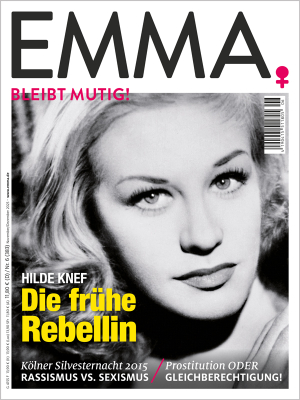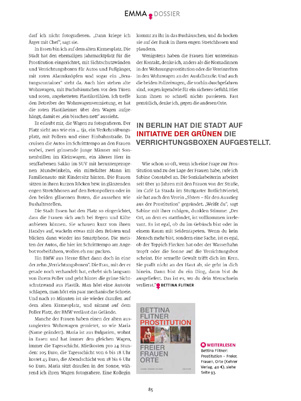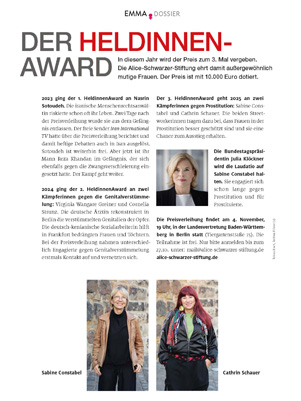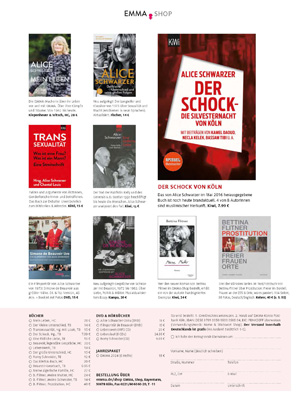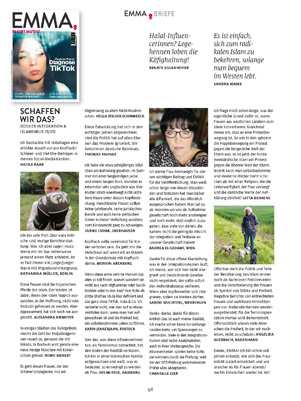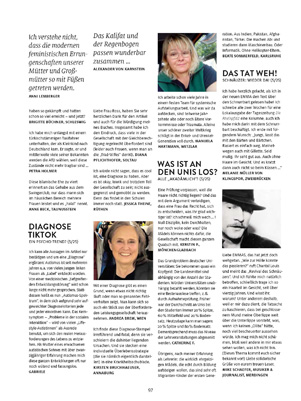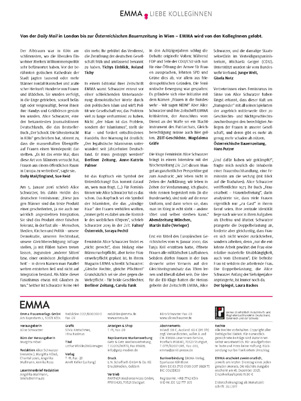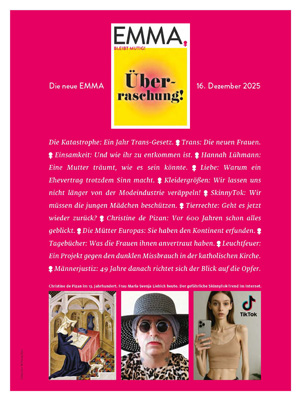A human being is not a program
The book is in two parts. Anna Dünnebier, a television Journalist who created a portrait of Schwarzer for the German TV channel ARD in 1980, authored Part I [The Biography], except for three brief chapters focused on specific controversies. Those three chapters and Part II, "Zwei Jahrzehnte Peinlichkeiten" [Two Decades of Embarrassing Situations], were authored by Gert von Paczenksy, founder ofthe TV-magazine "Panorama." Photographs from five decades of Schwarzer's life help readers keep track of some of the major personalities. An appendix contains a chronology of Schwarzer's life up to the founding of EMMA in 1977 and lists publications, major initiatives and awards through 1998. An index of persons concludes the book.
Early chapters present "defming moments" in Schwarzer's life. Born to an unmarried mother and raised by impecunious, left-leaning grandparents who gave her much freedom, she had a childhood that, at least in retrospect, qualifies as "good preparation for a rebellious life" (p. 11). Essentially self-supporting after age 16, she drifted through apprenticeships and office Jobs before deciding, at age 21, to seek a career in journalism. After a year in Paris studying French and broadening her political horizons, Schwarzer secured a traineeship with the Düsseldorfer Nachrichten, where she earned respect for her energetic, innovative reporting and also a couple of reprimands for caustically critical articles about prominent public figures. She later worked briefly for Frau und Film [Woman and Film] and the satirical magazine Pardon before returning to Paris as a freelance political correspondent.
The years in Paris (1970-74) were decisive for Schwarzer's career. She wrote to support herseif and began studying at the Faculte de Vincennes/Paris, where students could be accepted without an Abitur [High School Examination]. She became active in the French women's movement and met many well-known feminists, among them Monique Wittig and Simone de Beauvoir.
Profession and activism soon converged: "She was one of the dozen hard core members of the MLF [French women's movement, Mouvement de liberation des femmes]—but at the sanie time she was 'outside' .... She organized the same actions that she later wrote about, normally a taboo" (p. 67). Having participated in the French campaign against the ban on abortion, she was inspired to organize a similar action in Germany, "Ich habe abgetrieben" [I have had an abortion]. Reported in the mainstream magazine Stern in 1971, this action is credited with launching the second-wave women's movement in Germany.
Many chapters and episodes make ex-citing reading. Schwarzer's creativity in the face of obstacles is admirable. With no prospect of funding to Start a magazine on the model of Gloria Steinern's Ms, she had the genial idea to begin on a smaller scale; the result was the first Frauenkalender [women's calendar] in 1975, which turned a sizable profit; in the same year The Little Difference became a runaway best-seller, with earnings that brought plans for the magazine closer to reality. The chapter "EMMA—Eins schwere Geburt" [EMMA— A Difficult Birth] reviews Schwarzer's clashes with the Berlin founders of a rival feminist magazine Courage and her nearly disastrous attempts to run the magazine's staff as a "collective," with the inevitable contradictions of a project based on identity politics: EMMA was supposed to be better than all other magazines, yet also publish whatever women wrote (p. 130). Through-out, we see Schwarzer as the guiding force and also the one who does most of the work. Her commitment was and is unmatched— but one wonders what EMMA would be like had she been more inclined to share power, decision-making, and editorial control.
The chapters by Gert von Paczensky give background on a number of much-publicized scandals and controversies, among them "Der Aufstand der 32" [The Uprising of the 32], as reported here, a trumped-up internal dispute over Schwarzer's leadership style that was "leaked" to the public; "Lärm aus der Baracke" [Noise from the Barracks], another trumped-up charge, this time an accusation by the SPD press service that Schwarzer had advocated an election boycott; and the "Stern-Prozess" [Stern Trial], in which Schwarzer sued the magazine Stern because of its sexy cover photos. The suit was dismissed, but according to von Paczensky, the court was sympathetic to Schwarzer's position.
More disquieting are controversies surrounding Schwarzer's standpoint on Islamic fundamentalism, for which she has been much criticized. A prominent example was the publication in EMMA (July/August 1993) of a dossier titled "Fundamentalism" that began with the words "Fanatics and fundamentalists kill in the name of their truth and their arrogance" (p. 227). The "Mediawatch" office of the Heinrich-Böll Foundation responded, accusing EMMA of racism. Anti-racist feminists in Germany and elsewhere were also critical of Schwarzer and EMMA for evading difficult questions about Germanness, race, and responsibility (e.g., Sara Lennox, German Studies Review XVII, 3 [October 1995], pp. 481-502). Von Paczensky defends Schwarzer's position, but the reader longs for a voice that looks critically at all sides in this debate—not to try to force Schwarzer into a politically correct stance, but to take the accusations and her responses seriously.
By Jeanette Clausen, Feminist Europe, 2008 - Review of Anna Dünnebier & Gert von Paczensky: "Das bewegte Leben der Alice Schwarzer. Die Biographie. " [The Activist Life of Alice Schwarzer. The Biography] Kiepenheuer & Witsch, 1998/ Knaur Taschenbuch, 1999.
